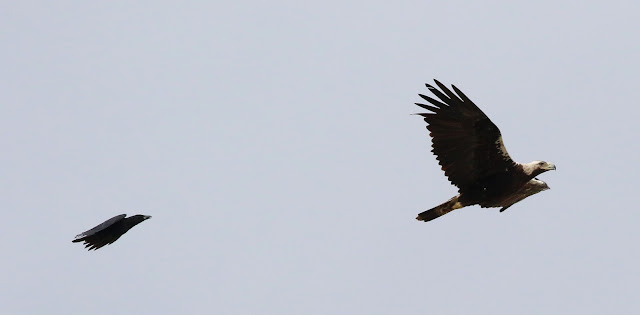Useful and interesting information on the species and its conservation in Portugal (also in English) can be found here: http://lifeimperial.lpn.pt/en
I wrote a six pages article for the April 2018 - edition of Germany's leading bird magazine "Der Falke" on the bird life of Portugal's Baixo Alentejo-region, highlighting also the return of Iberias "King of birds" to Portugal as a breeding bird: https://www.falke-journal.de/der-falke-42018/
Yesterday, 18.06.2018, I saw a Little Swift (Apus affinis) near Cape S. Vincent, the Algarve's western cape ! It was feeding in an area, where also a good gathering of the local breeding Pallid Swifts (Apus pallidus) and Alpine Swifts (T. melba) took place. This species nests in Morocco and there are some small colonies near the Strait of Gibraltar in Spain (Chipiona-harbor, f. i.) but not in Portugal, as far as known and is a rare vagrant with less than one observation per year. Over the last week alone however, five observations in different locations in the west Algarve (including also Foia/Monchique and the Alvor estuary had been made, three of which by a single observer, suggesting that we have an influx of this species in the Algarve right now. I tried my luck yesterday and managed to find one! For me a new bird for Portugal and species number 334 for the Algarve-region. Ironically I only recently watched this species in South Morocco, during a great 8-days birding trip in late March/ early April this year, into the high Atlas mountains and the Sahara desert. If you plan on this (and I can only say its worth while) you should contact http://www.gayuin.com/ who organized an unforgettable and very successful day trip for the desert specialities for us from Merzouga. I took tons of photos and might post some of them here on this blog later.
A good number of rarities I found myself this last winter and spring, including a Sociable Lapwing at Lagoa dos Salgados in November (later seen by many as it stood there till March) a 1st winter Caspian Gull, Lesser Yellowlegs, two different Pectoral Sandpipers, another (now anual) Yellow-browed Warbler and a Spotted Sandpiper in March at the Ria Formosa in Olhão, which stood there until early May, when it was in full breeding plumage. Quite a looker! See for yourself ...
 |
| Spotted Sandpiper (Actitis macularius), Olhão, 23-April-2018. A very rare vagrant from North America... Photo: GS. |
 |
| Spotted Sandpiper (Actitis macularius), Olhão, 23-April-2018. Photo: Georg Schreier. |
 |
| Spotted Sandpiper (Actitis macularius), Olhão, 23-April-2018. Photo: Georg Schreier. |
 |
| Spotted Sandpiper (Actitis macularius), Olhão, 23-April-2018. Photo: Georg Schreier. |
Finally - I highly recommend you join a Pelagic boat-trip to see Shearwaters, Skuas, Storm Petrels and others (often also Dolphins) off the Algarve coast ! Its one of the best things to do during the hot summer months...
All information is on my website here: http://www.birdwatching-algarve.com/pelagic-boat-trips.html
The next scheduled trips are for July, 12th; July, 21st (Saturday) and July, 31st so far (Fuzeta), other dates on request !
Some more trip reports of pelagics are here on this blog: here, here, here and here.
Hoping to see you soon !
Hoping to see you soon !
 |
| Great Shearwater (Ardenna gravis) off Fuzeta, Algarve, 26-September-2017. Photo: Georg Schreier |










